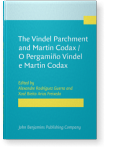Chapter 3
The Metrics of Martin Codax
This paper analyzes interrelated aspects of metrics in the seven cantigas d’amigo of Martin Codax: strophic design; the rhetorical technique of interlocking repetition with variation called leixa-pren; and theoretical connections between form, rhetoric and ease of cognitive processing (drawing on Nigel Fabb 2014, 2015). It also argues that a metrical analysis of these poems supports the thesis that they constitute an organized sequence.
Article outline
- 1.Form
- 2.Rhetoric
- 3.A sequence?
- 4.Magic
-
Notes
-
References
-
Appendix
References (20)
References
B = Biblioteca Nacional de Portugal (Lisbon), cod. 10991.
Calvia, Antonio. 2016. “The Music of the Pergamino Vindel
.” In Pergamino Vindel, ed. by Mariña Arbor Aldea, 263–283. Barcelona: M. Moleiro.
Cohen, Rip. 2003. 500 Cantigas d’Amigo: Critical Edition. Porto: Campo das Letras.
Cohen, Rip. 2005. “In the Beginning was the Strophe: Origins of the Cantiga d’Amigo Revealed!” In Modelo: Actas do X Colóquio da Secção Portuguesa da Associação Hispánica de Literatura Medieval, ed. by Ana Sofia Laranjinha and José Carlos Miranda, 243–255. Porto: Faculdade de Letras da Universidade do Porto.
Cohen, Rip. 2010. “
Cantar Igual: External Responsion and Textual Criticism in the Galician-Portuguese Lyric.” La Corónica. A Journal of Hispanic Languages, Literatures & Cultures 38.2: 5–25.

Cohen, Rip. 2013. “aaB: Strophic Design and Cognition.” Cognitive Philology 6. <[URL]>
Cohen, Rip. 2014. The Cantigas of Pero Meogo. Edited with Introduction and Commentary. [Washington DC]: Virtual Center for the Study of Galician-Portuguese Lyric. <[URL]>
Cohen, Rip. 2016a. “The Cantigas of Martin Codax, edited with commentary and prolegomena.” In Pergamino Vindel, ed. by Mariña Arbor Aldea, 285–305. Barcelona: M. Moleiro.
Cohen, Rip. 2016b. “aaBBB: The Strophic Form of Fernan Rodriguez de Calheiros 7.” Revista Galega de Filoloxia 17: 33–51.

Cunha, Celso Ferreira. 1999. Cancioneiros dos Trovadores do Mar. Ed. by Elsa Gonçalves. Lisbon: Imprensa Nacional-Casa de Moeda.
Fabb, Nigel. 2014. “The verse-line as a whole unit in working memory, ease of processing, and the aesthetic effects of form.” Royal Institute of Philosophy Supplement 75: 29–50.

Fabb, Nigel. 2015. What is poetry? Language and Memory in the Poems of the World. Cambridge: Cambridge University Press.

Gell, Alfred. 1995. “Technology and Enchantment.” In Anthropology, Art and Aesthetics, ed. by Jeremy Coote and Anthony Shelton, 40–63. Oxford: Basil Blackwell.
Huron, David. 2006. Sweet Anticipation: Music and the Psychology of Expectation. Cambridge MA: MIT Press.
Maas, Paul. 1962. Greek Metre. Trans. Hugh Lloyd-Jones. Oxford: Clarendon.
Miller, George A. 1956. “The Magical Number Seven, Plus or Minus Two: Some Limits on Our Capacity for Processing Information.” The Psychological Review 63: 81–97.

N = Morgan Library and Museum (New York), ms. M.979.
Parkinson, Stephen. 2006. “Concurrent patterns of verse design in the Galician-Portuguese lyric.” In Proceedings of the Thirteenth Colloquium (Papers of the Medieval Hispanic Research Seminar, 51), ed. by Jane Whetnall and Alan Deyermond, 19–38. London: Department of Hispanic Studies, Queen Mary, University of London.
Parkinson, Stephen. 2016. “Métrica acentual nas cantigas de amigo.” In Do Canto à escrita: Novas questões em torno da Lírica Galego-Portuguesa – Nos cem anos do pergaminho Vindel, ed. by Graça Videira Lopes and Manuel Pedro Ferreiro, 29–42. Lisbon: IEM – CESEM.
V = Biblioteca Apostolica Vaticana (Rome), cod. lat. 4803.
Cited by (1)
Cited by one other publication
Goldberg, K. Meira
2023.
Singing of and with the Other: Flamenco and the politics of pastoralism in medieval Iberia.
postmedieval 14:2-3
► pp. 393 ff.

This list is based on CrossRef data as of 27 july 2024. Please note that it may not be complete. Sources presented here have been supplied by the respective publishers.
Any errors therein should be reported to them.
